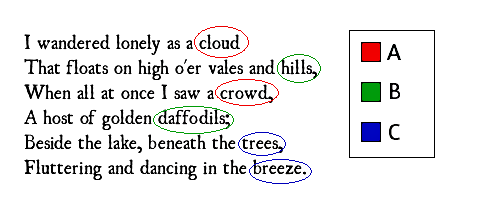William Wordsworth’s 1804 poem “I Wandered Lonely As a Cloud” remains one of his most famous and beloved works. In this short lyric poem, Wordsworth captures the vivid beauty of nature through an ordinary yet profound experience – watching a field of daffodils swaying in the breeze. With skillful use of poetic techniques, he invites the reader along on this experience while exploring themes of memory, isolation, and imagination.
Outline/Overview – I Wandered Lonely As a Cloud
Let’s break down this classic Romantic poem and analyze its key elements:
- Summary of the poem’s narrative
- Analysis of poem’s main poetic devices
- Discussion of prominent themes
- Significance of the poem’s legacy
First we will summarize the straightforward story being told before analyzing how Wordsworth uses various poetic elements to bring this scene to vivid life. We’ll then unpack key themes Wordsworth develops regarding nature, memory, and imagination through this ordinary experience. Finally, we will touch on why this poem remains so widely beloved more than 200 years later as a highlight of Wordsworth’s oeuvre and a quintessential English lyric poem.
Summary of Poem’s Simple Narrative
The poem relates a simple story told from the poet’s perspective – while wandering solitary across the countryside, he happens upon a field full of golden daffodils dancing in the breeze along a lake. But this picturesque scene turns into much more as the speaker reflects on how the memory seems to lift his mood when he’s feeling lonely or ennui:
I wandered lonely as a cloud
That floats on high o’er vales and hills,
When all at once I saw a crowd,
A host, of golden daffodils;
Beside the lake, beneath the trees,
Fluttering and dancing in the breeze.
For oft, when on my couch I lie
In vacant or in pensive mood,
They flash upon that inward eye
Which is the bliss of solitude;
And then my heart with pleasure fills,
And dances with the daffodils.
By William Wordsworth
In the first stanza, Wordsworth places us right next to him as he crests a hill and this cheerful scene suddenly appears before him. In just two lines, we share both his aimless wandering and his coming upon this field of daffodils that stretches along the lakeshore. Their movements – “fluttering and dancing in the breeze” – convey the carefree energy as they bend and sway together en masse.
The second stanza then jumps forward in time as the poet reflects back while lying alone on his couch. In a conversational tone that invites us to identify with his mood shifts, he describes how picturing those daffodils again in his mind’s eye lifts his spirits when he feels melancholic or unmotivated. This pleasing memory triggers an equally cheerful response from his heart, which feels like it too is “dancing” along with those daffodils.
Though framed as a basic nature observation, Wordsworth suggests both the scene’s effect in that particular moment as well as its ability to cheer the poet up later on. This dual perspective shows how deeply this ordinary moment endures.
Analysis of Key Poetic Devices
Despite the simplicity of the narrative, Wordsworth relies on several key poetic devices to vividly recreate this scene and its emotional impact on both the speaker and the reader:
| Poetic Device | Effect & Analysis |
|---|---|
| Iambic tetrameter | Evokes a rising/falling rhythm mirroring the swaying daffodils through consistent four-beat lines |
| Figurative language | Compares the wandering speaker to a cloud to emphasize his isolation and detachment from society |
| Imagery | Vivid sensory descriptions of the daffodils “[f]luttering and dancing” alongside the personified lake create a dynamic living landscape |
| Symbolism | Daffodils represent nature’s joy and imagination’s ability to recall that joy in bleak moments to come |
The most distinctive technical feature is the poem’s tightly structured meter. Each line contains four iambs – metric feet with an unstressed syllable followed by stressed one – creating an alternating “da-DUM, da-DUM” rising/falling rhythm. The bouncy iambic tetrameter mimics a heartbeat, evoking the fluttering movements of those golden daffodils swaying haphazardly en masse.
For example, let’s scan the meter in the first two lines:
I wan|dered lone|ly as a cloud (4 iambs = iambic tetrameter)
That floats| on high| o’er vales and hills (4 iambs = iambic tetrameter)
The daffodils’ physical form also echoes the poetic meter – slender stems atop which bob their yellow flower heads. This mirroring structure reinforces the speaker’s connection to the scene.

In addition to rhythm, Wordsworth relies heavily on figurative language and imagery to convey the speaker’s perspective. He sets up the poem’s central symbol – the solitary cloud – in the very first line as the reader becomes that “lonely cloud” drifting above the countryside, observing the beauty below. This floating perspective emphasizes the speaker’s sense of detachment from society and human company, even as he takes aesthetic pleasure in the rural landscape.
Wordsworth then unleashes a barrage of vivid sensory imagery, bringing the scene to life before us. The daffodils “[f]lutter and dance” alongside the “trees” and “lake” – the only active objects in this living tableau. The combination of visual (“golden”), kinetic (“fluttering”), and auditory (“dance”) images renders this nature scene dynamic and inviting. We experience the daffodils anthropomorphized as joyful dancers, just as the speaker does in that moment.
Finally, the most iconic symbol Wordsworth introduces is of course the daffodils themselves. In the Romantic tradition, flowers often represent the ephemeral beauty and pleasure found in the natural world. Daffodils specifically arrive each spring as winter fades, associating them with rebirth, radiance, and imagination’s triumph over hardship.
The joy Wordsworth feels in this scene passes from the daffodils, to his heart, and finally to the reader through his skillful use of poetic devices that place us within the speaker’s perspective.
Discussion of Prominent Themes
Within this basic nature observation, Wordsworth develops several themes centered on humanity’s relationship with the natural world:
- Embracing imagination and beauty in isolation
- Finding pleasure through appreciating nature’s renewal
- Power of memory to sustain us emotionally
At the core of Romantic poetry lies the premise that nature inherently restores our imaginative energy and capacity for joy. The speaker represents a model appreciator as he fully engages his imagination in the landscape before him then carries that vision within to later inspire his solitude.
For Wordsworth, achieving such imaginative restoration hinges on approaching nature purposelessly, with an open and attentive perspective – traits the wandering lonely cloud embodies. The speaker mirrors that receptiveness through simple observation that deepens into rapt engagement.
We as readers experience the restorative power represented by those dancing daffodils as we initially view them alongside the poet then feel their remembered presence stir our emotions too. Though nature writing often trends toward the descriptive, Wordsworth’s blank verse lyricism relies more on evocative imagery to cultivate a desired perspective within the reader.
In the second stanza, the contemplative view of memory recasting this scene as a touchstone that lifts the poet’s mood further supports the Romantic perspective on nature’s psychological restorative abilities.
The poem suggests even a fleeting encounter with natural beauty imprints itself indelibly on the human heart. Recalling that vision when “[i]n vacant or in pensive mood” counteracts melancholy or existential questions through imagination’s transformative lens – a remedy accessible to all.
Beyond the speaker himself, the daffodils symbolize imagination, renewal and enduring inspiration. Their arrival each spring represents nature’s perpetual capacity for renewal after hardship. Winter passes, flowers bloom, hope springs eternal.
The transient blooms themselves remain beautiful yet ephemeral. But as imagination’s embodiment, the daffodils let the viewer carry that joy within to be recalled as needed – their dance preserved in memory.
So in reflecting on this ordinary moment, Wordsworth touches on life’s enduring cycles and human perception’s power to imbue our experiences – however fleeting – with imaginative resonance that sustains our emotional lives.
Significance of Poem’s Legacy
Now over 200 years old, “I Wandered Lonely As a Cloud” remains one of Wordsworth’s most prominent works and a classic English lyric poem. Critics and casual readers alike continue responding to how this straightforward verse vividly epitomizes core Romantic values regarding humanity’s bond with the natural world and imagination’s centrality to our inner lives.
Alongside “Tintern Abbey”, this poem helped cement Wordsworth’s reputation both as the quintessential nature poet and as a skilled practitioner of blank verse lyricism that sought to capture essential human experiences. Though published in collections amongst his longer philosophic pieces, “Daffodils” endures on its own across centuries and languages thanks to this universal yet distinctly Romantic snapshot of solitary wonder transformed into shared inspiration.
The deceptive simplicity of the scene’s emotional resonance continues impacting readers and expanding influencers, from poets to politicians to activists like Berta Cáceres whose environmental campaigns echo Romantic astonishment toward nature’s threatened magnificence. Wordsworth may have wandered lonely across that field, but his poem leaves a crowded legacy that still blooms today.
Conclusion
In “I Wandered Lonely As a Cloud”, William Wordsworth created a Romantic vision of nature’s power to exalt imagination beyond isolation and restore the human soul – a perspective that profoundly impacts environmental and psychological philosophies still evolving today. Through masterful use of imagery, symbolism, meter and other poetic devices, this short lyric immerses readers in the speaker’s experience – first observing that host of golden daffodils with him, then feeling memory of their dance lift our hearts alongside his own.
Across two breezy four-line stanzas, Wordsworth conveyed the imaginative resonance of a fleeting yet memorable encounter with natural splendor with a universality that continues inspiring new generations of readers across languages and cultures to value useless beauty, temporary joy and their lingering inspirations. For a poem that never strays beyond ordinary Blank verse simplicity, “Daffodils” displays extraordinary power to compel engagement with its Romantic view on poetry’s role in reframing perception.
By coaxing readers into imaginitive unity with that lone wandering cloud, Wordsworth offered seekers of beauty and meaning a masterclass in recognizing unanticipated soul-stirring glory amid the landscapes we traverse, treasuring ephemeral wonders that so lift the human heart, and carrying talismans of inspiration within to sustain our way forward.









